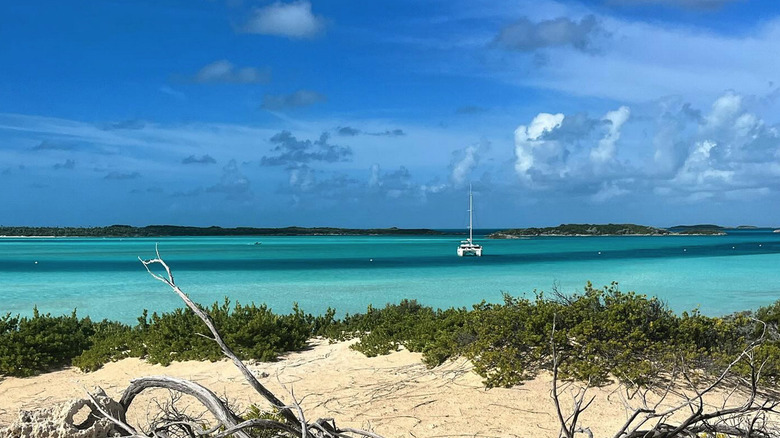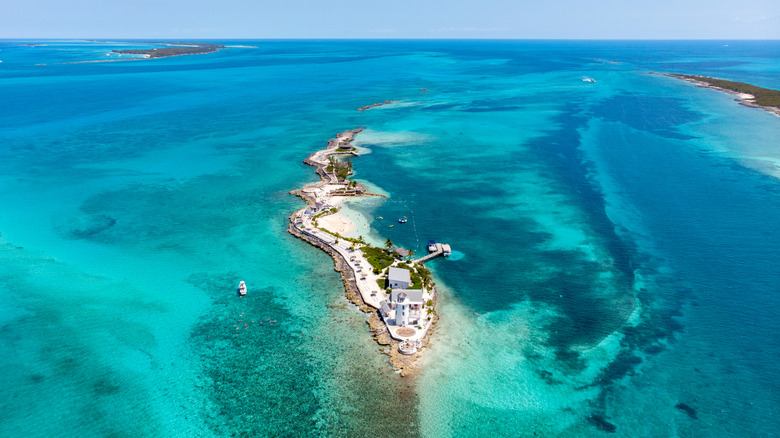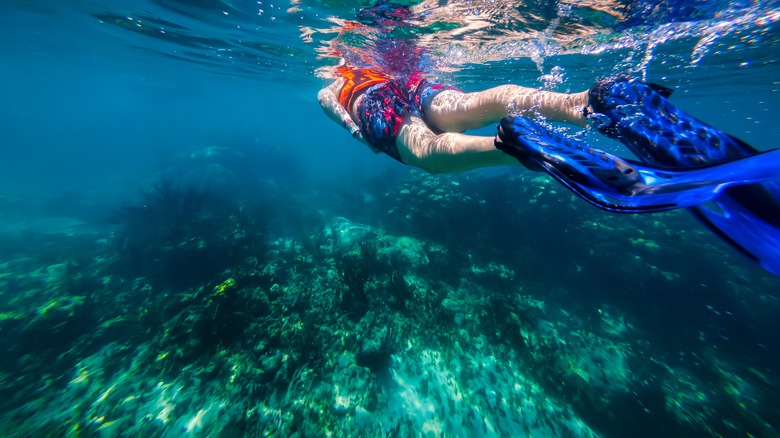15 Popular Snorkeling Spots In The Bahamas
The Bahamas, an archipelago of more than 700 islands and cays, is an aquatic wonderland. It spreads over the Atlantic Ocean from Grand Bahama Island to Great Inauga Island. The former is close enough to Florida that, on a map, the two almost touch , while the latter hovers above Haiti and a stone's throw from the east of Cuba. Between all those dots of land seeps fantastically blue and improbably clear water that begs to be experienced via a dive, snorkel, or swim. As if that weren't reason enough to make a trip to the Bahamas enticing, that water is warm year-round and has incredible visibility, with up to 200 feet of unhindered sight not unheard of. Snorkelers might be more comfortable in a short wetsuit in the cooler months.
Given such aquatic achievements, it's little wonder that the Bahamas has some of the best islands in the world for snorkeling and a variety of things to see. The list below only scratches the surface of all the snorkeling that the Bahamas offers, but these are among the destinations not to miss. We've made our picks using information gleaned from diving blogs, snorkeling blogs, travel blogs, Bahamas national parks sites, and reviews from travelers. Since the Bahamas is not a chain of islands safe from hurricane season, travelers should visit from November through May for optimal weather.
Andros Barrier Reef
Andros Island is a conglomeration of hundreds of islands and cays separated by channels, mangroves, estuaries, and swamps. It's located just west of New Providence, the island home to the Bahamian capital and cruise port of Nassau. Three main chunks comprise the lion's share of Andros — North, Middle, and South — the largest island in the Bahamas. Off its east coast, visitors will encounter Andros Barrier Reef. The third-longest barrier reef on the planet, this coral realm can be enjoyed at the North & South Marine Parks.
The parks protect thousands of acres of the over 124-mile-long reef where snorkelers can see grouper, lobster, snapper, hard corals, and hypnotic gorgonians like sea fans. Boats are the only way to get to the park's two halves, which might make it better for more adventurous individuals. This part of the Earth is a fabulous destination for yacht charters. The well-established boat charter company The Moorings has two bases in the Bahamas.
Blue Lagoon Island
A short trip northeast of Nassau, this tourist island, also known as Salt Cay, has been carefully developed as a commercial enterprise. Lovers of marine mammals will likely remember it for the chance to observe and hang out with dolphins, but it's also an excellent destination for snorkelers. Given that it can easily be reached from Nassau, Blue Lagoon Island pulls in the cruise crowds when a ship docks; the fine beaches, clear turquoise sea, and range of activities on the private isle draw passengers.
A typical package includes boat transfers from Nassau, lunch, use of facilities like a bouncy park, hammocks, volleyball courts, and beach chairs, and the chance to see the dolphins in their special pen and even swim with them. The water in the island's lagoon is shallow and calm, making it great for kids or adults who aren't entirely comfortable in the open sea. The marine life includes barracuda, crabs, jellyfish, and snappers. The ease of getting to Salt Cay makes this a smart choice, and the ancillary options ensure snorkeling isn't the only diversion.
Deadman's Reef
Almost due east of West Palm Beach in Florida, this reef on Grand Bahama is often seen as part of a tour. Access to Deadman's Reef comes via Paradise Cove, a collection of beachfront villas where units come with full kitchens and slightly faded, beachy decor. But you don't have to be a guest to enjoy the reef: you can book a tour through the resort that includes hotel pick up, gear, and up to six hours in the water. Snorkelers can also just show up, but they are expected to have pre-paid the $6 site entrance fee.
Once in the water, visitors might spot a series of sunken concrete balls added to the seabed in 2014 as places for coral to grow. The 300 structures also dampen the effects of the incoming waves and tide, helping to keep the shallows calm and clear and reducing beachfront erosion. This artificial reef has flourished, and now Deadman's Reef brims with turtles, parrotfish, angelfish, and much more.
Devil's Backbone
Named for the coral formations that make boating tricky, this area north of the delicately shaped island of Eleuthera has great shallow reefs. The destination's name seems quite appropriate when you look at Eleuthera on a map since its fine, skinny ribbons of land almost seem like the fragile, slender ridges of a collarbone. From above, the reef appears as a succession of submerged, tightly packed formations (like a spine) running for miles up the sea. While it's visually appealing, Devil's Backbone has spelled disaster for boats. Many vessels have met their end on the shallow reef, and you can even spot some in the water.
Thankfully, snorkeling is first-rate in this area, with the kind of visibility that makes the Bahamas a water lover's paradise, and creatures like moray eels, stingrays, and lots of coral, including large brain coral formations. It's also great for travelers who enjoy swimming with sharks. You could spend many hours exploring Devil's Backbone and not see it all, so consider booking an excursion with local operator Ocean Fox. Since the reef is on the Atlantic-facing side of the island, the water can get wavy, so beginners should sit this one out.
Exuma Cays Land & Sea Park
Exuma Cays Land & Sea Park encompasses a necklace of islands and surrounding water, from the Shroud Cays in the north to Little Bells Cay in the south. Set up in 1958, it was the first marine park in the Bahamas. It includes more than 110,000 acres of sea, sand, and scenery, with ribbons of reef, mangroves, and seagrass, and beaches perfect for taking a break and soaking up the magnificence of it all. There are no resorts, fishing is banned, and you'll only find hiking trails on some islands. This really is a place where nature rules, though there is an informative visitor's center on Warderick Wells Cay.
Anyone with a boat can gain access to Exuma Cays Land & Sea Park, and charters are the way to go if you want to enjoy as much of the blue and green seas as possible. Leap in anywhere, and you'll likely see a variety of species. One spot not to miss is known as the Aquarium, which is located near O'Briens Cay. The water thrums with rays, octopi, corals, fish, and turtles, and all will be easy to spot, given the impressive water clarity.
Fowl Cays National Park
From their boat, visitors will likely be able to see the sandy sea bottom or seagrass of the shallower parts of this national treasure in the Abacos chain of islands. Fowl Cays National Park was established in 2009 and has fine coral reefs where the snorkeling is phenomenal, a clear and magical sea, and a sense of un-trafficked purity that is hard to believe. Kick through the turquoise seas, and you'll likely spot baitfish, coral, reef sharks, and more.
One of the highlights is the chance to swim alongside wild sea turtles, though snorkelers should be careful of them and keep a distance to avoid stressing the creatures. Travelers who don't have the desire or means to charter their own boat can book a snorkel tour of the park with Snorkel Adventures Bahamas. The nearest accommodations are on Great Guana Island, where visitors will also find comely beaches, rental villas that draw some famous names, and a fancy resort with a golf course.
Goulding Cay Reef
Goulding Cay Reef is an easy excursion to organize for visitors staying in the capital of Nassau or elsewhere on New Providence Island. It sits close to the island's west coast, and the tops of the reef formation are only about 10 feet below the water's surface. The colors are electric, from the fish to the coral, with Elkhorn coral being the most prevalent type.
Thanks to the shallowness of the calm water and the ease of access from Nassau, this is a good spot for families looking for a snorkeling trip suitable for all levels. The reef is a distance from the shore, and the most efficient way to reach it is on a snorkeling tour with an operator like Stuart Cove's Dive Bahamas, which offers half-day excursions to shallow reefs, including Goulding Cay. Once you arrive, expect to see a good selection of corals, eels, rays, damselfish, snappers, and turtles.
Honeymoon Harbour
One of the closest Bahamian islands to Miami, Gun Cay is the destination for snorkelers looking to spot stingrays. Tiny and uninhabited, it's located near the pair of islands called Bimini and is a draw for the chance to interact with these graceful gliders. Named for the Gun Cay beach near the water where the rays congregate, Honeymoon Harbour has gorgeously clear seas, and snorkelers only need to shuffle off from the shore into the shallows to encounter the creatures.
Some visitors also slip off the side of boats, like those on a trip with Neal Watson's Bimini Scuba Center. They plunge into the gently lapping ocean and watch the rays ripple below, close to the sea floor. With conditions outside hurricane season that are generally calm and provide excellent visibility, this is a safe choice for families, even those with relatively young children. The experience and memories will be priceless.
Mermaid Reef
Close to Marsh Harbour, the central hub of the Abacos islands and home to an international airport, Mermaid Reef can be reached with little effort from the shore. Travelers will find plenty of lodging nearby, so they don't need to charter a boat or kick for eons to locate the reef. Despite the site's name, snorkelers won't find mythical sea beings but will see moray eels and snappers among the many other species that call this part of the Bahamas home.
While no specific government funding goes toward monitoring the reef, it is cared for by the local community, and researchers consistently check the health of the coral. Nearby schools regularly visit Mermaid Reef as part of field trips to help them understand the necessity and fragility of coral reefs. The calm water there makes it an excellent reef for snorkelers who are low on experience or confidence.
Pearl Island
Located northeast of Nassau, this private island is a popular day trip and offers snorkeling along reefs teeming with colorful fish. Pearl Island doesn't have rooms for overnight stays or a bewildering range of facilities but is more aligned with those looking for a tranquil getaway. A lighthouse at the western end of the island is the defining feature.
Elsewhere, visitors can lounge on a couple of white-sand beaches, paddle around on a kayak, rent a private cabana with a view of the sea, get a bite to eat, or order a drink at a bar that looks over the wild blue yonder. The water is the most hypnotic part of a visit to Pearl Island, often shimmering in the sunlight with an effervescent turquoise glow. You'll experience its clarity on a snorkeling tour led by island guides, where likely encounters include porcupine fish, Bahamas grunts, moray eels, and lionfish.
Pelican Cays Land and Sea Park
Another destination that can be a day trip from Marsh Harbour on Great Abaco, Pelican Cays, is only accessible by boat. It can be a challenging site, but the snorkeling is incredible, with vast areas of reefs. More than 50 years old, it encompasses about 2,000 acres of reefs, and while that size is an impressive enough statistic, what is even more enviable is the large number of coral species that thrive here.
Among the highlights are many fan corals that wave in the rippling water and finger sponges that appear as delicate as they sound. Marine life includes spiny lobster, turtles, and, of course, lots of colorful fish. For some, the highlight might be seeing gangs of eagle rays gracefully scoping out the sandy sea bed. When it's windy, the choppy conditions and stronger surges will make this site unsuitable for inexperienced snorkelers.
Peterson Cay National Park
This park sits opposite Peterson Beach on the south coast of Grand Bahama. Still, it is some distance away, making access from that beach all but impossible (kayaking there from Grand Bahama is a more realistic option). It's a tiny park — the smallest in the country — a rocky cay that suddenly appears adrift in the sea and feels barren, bereft of life. But this limestone dot of land plays a significant role in the local ecosystem. Peterson Cay is a critical nesting arena for bridled terns, a sleek seabird with black, white, and gray tones and an impressively broad wingspan.
Off the land, the seas are as majestic as the serene setting might suggest, with fantastic clarity and profound density of life. Partnering with the port operator on Grand Bahama, the park created a coral nursery in its waters, with coral and staghorn corals growing as part of the enterprise. The success is apparent, with bright fish shimmying around the shallows, as snorkelers will undoubtedly see on tour with Grand Bahamas Nature Tours.
Rainbow Reef
Off the coast of North Bimini, an island due east of Miami, this shallow reef has about 100 fish species, and it's a good spot for beginners. Though it's also a popular dive site and only accessible by boat, the reef sits in relatively shallow water and can easily be enjoyed as part of a snorkeling adventure. The environment is marked by calm water, making it a place filled with young fish that are finding their sea legs.
Travelers will likely see small sergeant majors and damselfish darting in and out of coral or tucked away under rocks and overhangs, away from prying hungry eyes. Large creatures on the reef's lower sections include turtles, nurse sharks, and swarming schools of adult fish. Since there is a cruise port on North Bimini, this reef is often visited by passengers of ships that have booked an excursion directly through the cruise line.
Rose Island Reef
A long, skinny island that looks like a snake swimming through the sea, Rose Island gives its name to this fabulous reef. It's easy to reach from Nassau—25 minutes by boat—and is a shallow reef with the expected handsome stock of fish and coral. The two wrecks that sit in the waters make the site stand out—"The Mahoney" and "The Alcora," which have become popular hangout spots for the local marine life.
Visitors can get to Rose Island by booking a tour with Sandy Toes, which has private beaches and offers guests the chance to swim with pigs in the sea. But, for a more in-depth exploration of the reef, reserve a full-day excursion with Barefoot Sailing Cruises. The trip includes breakfast and lunch, all equipment, and many hours in the waters around Rose Island. The adults might also enjoy the copious amounts of Bahamian rum punch poured by the warm hosts.
Sapona Shipwreck
A shipwreck is the attraction at this site off South Bimini Island. The "Sapona" sits in a shallow trough of water, making it easy to explore with a snorkel. It's become a well-known snorkeling site, a cargo vessel that got stuck in the shallows in 1926 after being caught in a hurricane. Thanks to its positioning in only 15 feet of water, it is easy to spot, though getting to the wreck requires boat access; consider booking a tour with Bimini Blue Adventures or through your cruise line if you plan to be in the area on a ship.
Almost a century after its untimely end, the ship is a virtual ecosystem unto itself, with separate sections that a snorkeler can effortlessly explore. Holding your breath, you can swim in and out of parts of the vessel, a thrilling option not part of a typical snorkel excursion. Of the many fish that commute to the "Sapona," expect to see eels, barracuda, snappers, and angelfish.
Methodology
We've made our picks through information gleaned from dive, snorkeling, and travel blogs, Bahamas national parks sites, and reviews from travelers. We also made sure to include a range of destinations, from relatively remote places and bereft of facilities to those with a much more commercial leaning that can be easily reached, whether you visit the Bahamas on a cruise ship or independently.
















